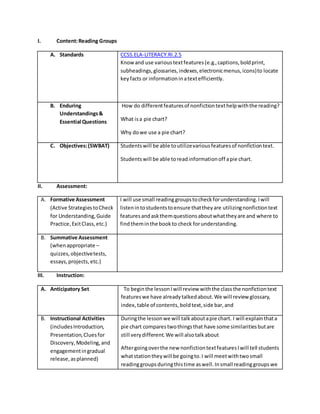
reading non fiction lesson
- 1. I. Content:Reading Groups A. Standards CCSS.ELA-LITERACY.RI.2.5 Know and use varioustextfeatures(e.g.,captions,boldprint, subheadings,glossaries,indexes,electronicmenus,icons)to locate keyfacts or informationinatextefficiently. B. Enduring Understandings& Essential Questions How do differentfeaturesof nonfictiontexthelpwiththe reading? What isa pie chart? Why dowe use a pie chart? C. Objectives:(SWBAT) Studentswill be able toutilizevariousfeaturesof nonfictiontext. Studentswill be able toreadinformationoff apie chart. II. Assessment: A. Formative Assessment (Active StrategiestoCheck for Understanding,Guide Practice,ExitClass,etc.) I will use small reading groupstocheckforunderstanding.Iwill listenintostudentstoensure thattheyare utilizingnonfictiontext featuresandaskthemquestionsaboutwhattheyare and where to findtheminthe bookto check forunderstanding. B. Summative Assessment (whenappropriate – quizzes,objectivetests, essays,projects,etc.) III. Instruction: A. Anticipatory Set To beginthe lessonIwill review withthe classthe nonfictiontext featureswe have alreadytalkedabout.We will review glossary, index,table of contents,boldtext,side bar,and B. Instructional Activities (includesIntroduction, Presentation,Cluesfor Discovery,Modeling,and engagementingradual release,asplanned) Duringthe lessonwe will talkaboutapie chart. I will explainthata pie chart comparestwothingsthat have some similaritiesbutare still verydifferent.We will alsotalkabout Aftergoingoverthe new nonfictiontextfeaturesIwill tell students whatstationtheywill be goingto.I will meetwithtwosmall readinggroupsduringthistime aswell.Insmall readinggroupswe
- 2. will workonusingnon-fictiontextfeaturestohelpusbetter understandwhatthe authoris tellingus. Word work – studentswill workonspellingwordwall words.They will workon recognizingbeginningmiddle andendsoundsaswell. Writing– studentswill workonformingsentencesusingsound spellingandcorrectlyspellingwordwall words.Studentswill work on having7 or more sentencescoverwho,what,where,when,why and be sure to include adjectives intheirwriting.Theywill also focuson havinga beginning,middleandendandmakingsure they are sequencingtheirstory. Partnerreading– Studentswill workwithapartnerto readto each otherand practice retelling(9or more thingsfromthe book) and makinga connection.Studentswill alsoworkonusingtheirreading strategiestofigure outwordstheydon’tknow. Readto self – Studentswill workonreadingontheirown.During thistime studentsshouldfocusontheirreadingstrategiessuchas askingquestionsandstretchingwordsoutthattheydon’tknow and othersthatwe have beenworkingon. IPads– Studentswill use the IPadstoworkonwordwork or listeningtostories.Studentswill workonretellingandmaking connectionstothemselvesfromthe storiestheylistento. With special attentionto i. Differentiation Readinggroupsreachall levelsof studentsbecause Iworkwithsmall groupsto ensure thatI am workingat theirlevel. ii. Higher Level Cognition Readinggroupsreachall levelsof studentsbecause Iworkwithsmall groupsto ensure thatI am workingat theirlevel. iii. Technology Studentswill use IPadstoworkonword workand listentobooks. C. Gradual Release Techniques(See Formative Assessment–Checkingfor Understanding,Guided Teacher - I will explaintostudentswhat apie chartis and have studentspractice readinginformationoff of afew differentones. Teacher/students–I will workwithsmall readinggroupstowork on askingquestionsandothernonfictiontextfeatureswe have
- 3. Practice,Independent Practice,ClassExit) beenworkingon.Iwill guide studentstouse theirstrategiesto figure outnew words. Students – Studentswill workontheirownatreadingstationsto workon wordwork,partner reading,readingtoself,andIPads. D. Closure To close the lessonIwill askstudentswhatwe have learnedand place the ‘I can’ statementsinthe chart. IV. Reflection: A. What Will TheyandI Do Next& Why? Nextwe will workon,how touse a glossarytolookup words.We will use thisinformationtohelpusunderstandwhatthe authoristeaching us.